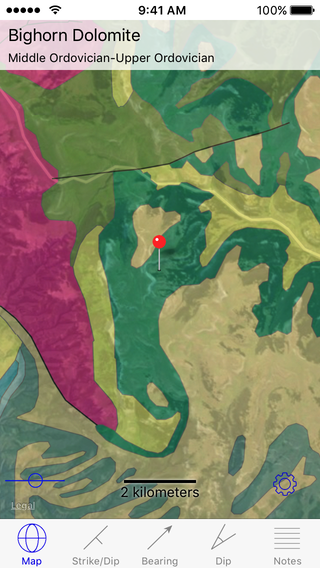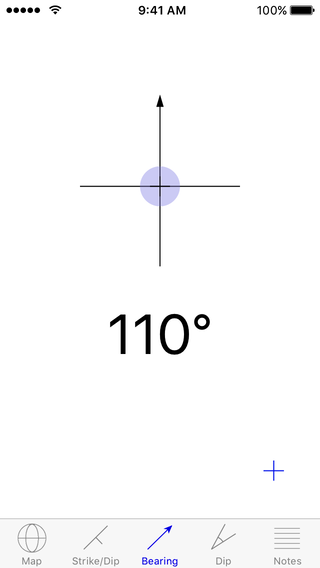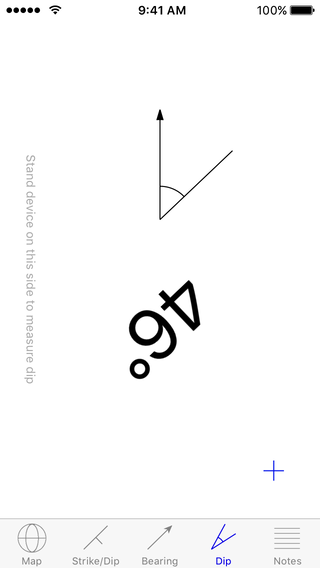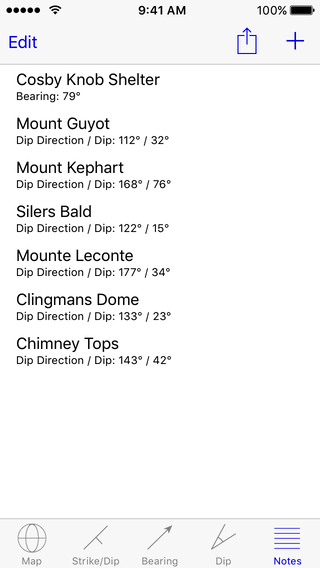Strike and Dip - Now with geologic maps!
Take your iPhone and iPad into the field
Your iPhone and iPad are about to become your indispensable tools for field geology! I used to carry a pocket transit, gps, camera, and field notebook, but no more — with Strike and Dip, I’m covered.
With Strike and Dip, you can instantly and simultaneously measure the strike and dip of any surface. You can take precision bearings and dips of any feature. You can save any measurement or save a note anywhere, and it is automatically tagged with the date, time, and GPS position. You can edit these notes, and now you can even add a photograph to your notes. You can easily export all of your data. Strike and Dip continually amazes me with its usefulness in my field work.

To measure strike and dip, just lay your device flat on the surface, and read your strike and dip. That’s it! It’s much simpler than the gymnastics of a pocket transit. You can also see your current GPS position and elevation, and the precision of those measurements. To save your strike and dip, tap the plus sign in the lower right, and your date, time, and GPS coordinates will automatically be added to your note.

Maps are a cool feature of Strike and Dip. Thanks to Macrostrat, maps now come with a geologic map overlay, and the quality of the map depends on what macrostrat.org has in their database. Tap on a point, and you can see data on the geologic unit. The locations of your notes are also shown on the map. Tap on one and you can see the notes you took at that spot.

Measuring a bearing is a snap. Just hold your device level, point the arrow, and read your bearing. Leveling your device is also easier now: just tilt it until the blue circle is centered on the target. To save your measurement along with the date, time, and GPS position, tap the plus sign in the lower right. Tap the crosshairs button in the lower left to use your camera to take a bearing on a distant object.

Measuring vertical angles like dip and plunge is also easy. Just stand your device on its side on whatever you are measuring, and you can see the angle that’s being measured. Tap the plus sign in the lower right to save your measurement, date, time, and position. The dip tool is great for measuring the angle of any feature, such as plunge or an apparent dip, especially when that might not be the same as the angle of dip.

Notes are the killer feature of Strike and Dip. When you tap the plus sign on any screen, you create a new note, which can include a strike and dip, a bearing, or a vertical angle. In your list of notes, tapping the plus sign makes a new note without a measurement. New notes are added to the top of the list, and they are editable: just tap and start typing. You can add a locality name at the top, and you can add notes at the bottom. Tap the camera button to add a picture to your note, and tap the thumbnail to see the photo — I love this feature and use it all the time!
It’s easy to get your notes off your device. When you’re viewing a single note, tapping the export button lets you email that note and its photo. When you’re viewing your list of notes, tapping the export button lets you save your data to iCloud or Dropbox, email them, or save them to iTunes (great for when you do not have internet access). You can even delete all your notes if you want to start with a clean slate. Your notes are saved in a comma-delimited file, which can be read by almost any program, including Pages, Numbers, Word, and Excel. You can also export your notes as .kml for GIS / Google Earth or as a .pdf file. All of your photographs are stored in the Photos app.
You can customize Strike and Dip to the way you work. Pick your favorite GPS format: degrees-minutes-seconds, degrees and decimal minutes, or decimal degrees. Bearings can be shown in azimuth or quadrant format. Distances can be shown in meters or feet. For strike and dip, choose from the right-hand rule, the north-half rule, or the dip-direction rule. Strike and Dip has you covered! The settings screen also shows your current magnetic declination and lets you calibrate your device on a level surface. If you get stuck, press help — but I don’t think you will need to.
Try it out - I’m sure Strike and Dip will become your indispensable field tool!
Have other questions? See the Strike and Dip FAQ.

